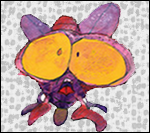 gNats Island is a computer game that implements key aspects of Cognitive Behavioural Therapy (CBT). It is designed to support face-to-face clinical interventions with adolescents aged 9-15.
gNats Island is a computer game that implements key aspects of Cognitive Behavioural Therapy (CBT). It is designed to support face-to-face clinical interventions with adolescents aged 9-15.
Impact: as of June 2014 over 1250 mental health professionals in Ireland, the UK and the US have received training in the gNats Island clinical intervention.
Publication: Coyle, D., McGlade, N., Doherty, G. & O’Reilly, G. (2011) Exploratory Evaluations of a Computer Game Supporting Cognitive Behavioural Therapy for Adolescents. ACM CHI 2011, full paper pp2937-2946. (pdf) DOI link.
Summary: In gNats Island players visit a tropical island and meet a team of wild life explorers. These characters introduce mental health concepts using spoken conversation, embedded animations, videos and questions regarding the player’s own situation. Players carry an in-game notebook, in which they answer characters’ questions and record new ideas. Negative automatic thoughts are presented as little creatures called gNats that can sting people, causing negative thinking. Each type of gNat – of which there are nine in all – is introduced with a cartoon, voiceover and story describing its effects. For example being stung by a Black and White gNat can cause people to think in extremes. gNats provide a concrete representation and means of externalising an important CBT concept. Through conversations with game characters players are introduced to strategies for identifying and challenging negative thoughts. Concrete metaphors such as catching, trapping and swatting gNats are used to describe this process. Similar approaches are used with other important CBT concepts, such as Core Beliefs. The materials in the game are adapted from the CBT Workbook for Young People by Gary O’Reilly.
Clinical Use: gNats Island implements CBT in a generalised manner and is intended for use with adolescents experiencing a range of difficulties, including depression and anxiety. It is designed to fully integrate with a six session, manualised, face-to-face intervention. Sessions typically last one hour, with the game used for 45 minutes. The therapist and adolescent sit together at a computer, but the adolescent has full control of the mouse and keyboard. Rather than talking face-to-face with the adolescent, the therapist is a partner in their exploration of the game world. Many of the issues that a therapist might normally raise are instead raised by game characters. As such gNats Island represents a substantial reshaping of the traditional therapeutic interaction. It aims to do so in a way that is supportive of the client-therapist relationship. The intention is that conversations with game characters provide a context for more detailed conversations between the adolescent and therapist.
Evaluations: the paper listed above contains a detailed description of the exploratory evaluations of gNats Island. Two further evaluations of gNATs Island have been completed and are being prepared for publication.